After spending most of Roberto Martínez’s reign on top of the FIFA world rankings, Belgium are now ranked as the second second-best team, behind Brazil.
They qualified for the tournament in good form remaining undefeated throughout their qualifying campaign, winning six and drawing two. Their form in the UEFA Nations League this year has been positive, although Roberto Martínez will be concerned that they came up short twice against the Netherlands, failing to score in either game.
They remain the clear favourites to top their group in Qatar which includes Canada, Morocco, and Croatia. Many consider this as the last chance for this golden generation of players to win major honours together.
This article will be a tactical analysis in the form of a scout report and will provide an in-depth look at Belgium’s tactics and how they plan to go at least one step further than their performance in 2018. We will provide data analysis on their attacking threat and defensive strategy, along with reviewing which players are likely to influence their tournament.
Predicted starting XI
The general perception is that this World Cup represents the last chance for Belgium’s “golden generation”. When you consider the age of the players that form the core of that generation you can understand that point, as the Belgian squad has ageing players across each position on the field.
Romelu Lukaku, Kevin De Bruyne, Eden Hazard, Dries Mertens, Alex Witsel, Toby Alderweireld, and Jan Vertonghen all remain fundamental to Belgium at this stage but in the team’s next tournament in 2024 the youngest of them will be 34.

In Amadou Onana, Charles de Ketelaere and Jeremy Doku they have talented players who are young with huge potential and who are all now becoming mainstays in Roberto Martínez’s squad, but the selection of players available to Belgium won’t match the quality of players who are now beyond their prime years.
Below is the starting XI we believe Roberto Martínez will be hoping he can start the tournament with.
Roberto Martínez will set Belgium up in a 3-4-3 formation. However, what variant of the 3-4-3 he plays will determine who plays as part of the three-man attacking line. The former Everton Manager has been flexible with his attacking line throughout both the qualifying and UEFA Nations League campaigns, switching between a 3-4-3, 3-4-2-1 and a 3-4-1-2.
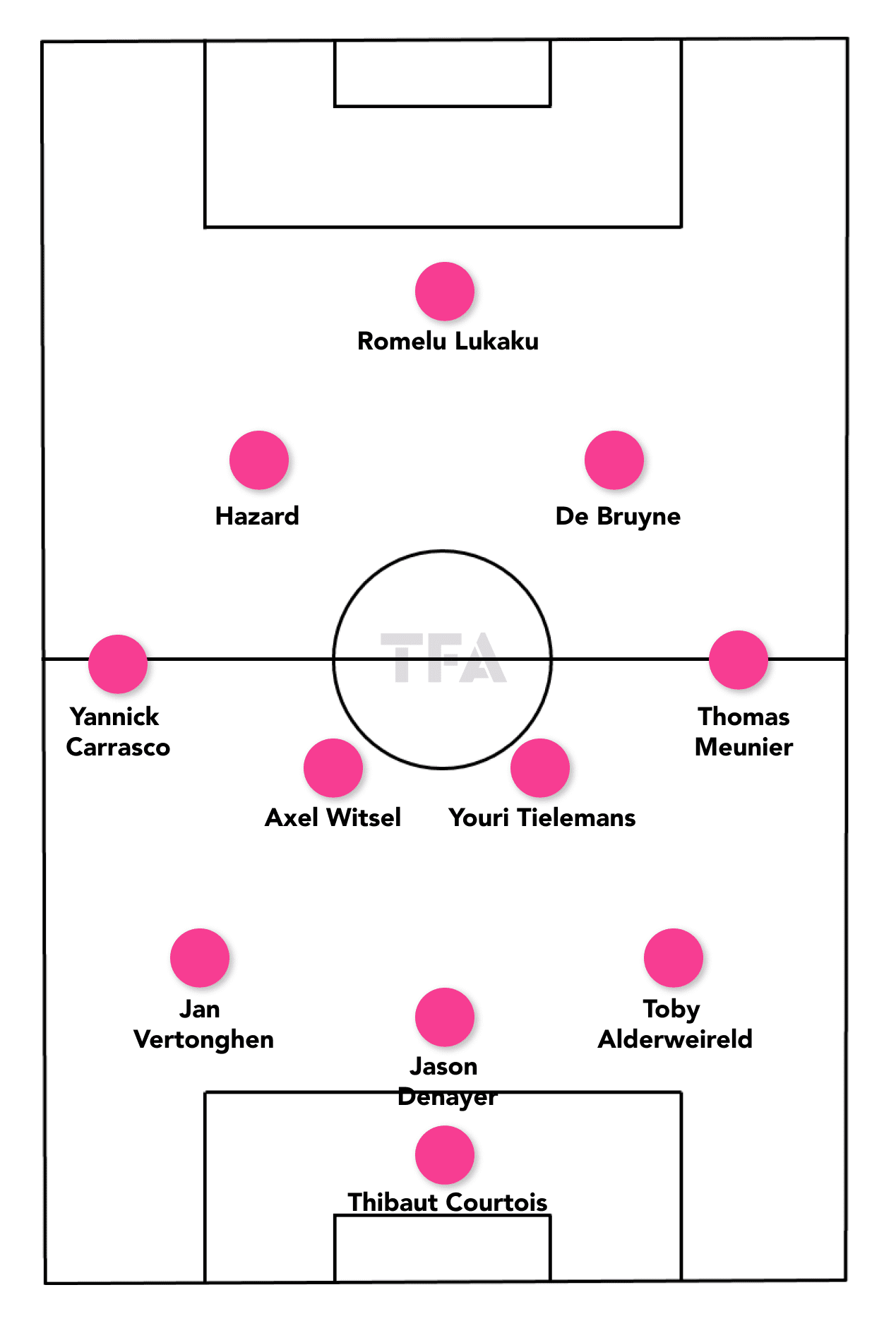
The 3-4-2-1 formation with two number 10s allows Martínez to be able to get both Hazard and De Bruyne in the team at the same time without compromising any defensive structure. They will no doubt be playing Romelu Lukaku, who is Belgium’s top scorer. Witsel and Tielemans will start as the double pivot that provides the balance in midfield and Amadou Onana will feature as the primary backup in this position.
Anderlecht defender Zeno Debast has started the last two UEFA Nations League matches and could well be the player to start the tournament alongside Jan Vertonghen and Toby Alderweireld. Although how Martínez sets them up positionally could prove decisive. Debast has been playing as the right centre-back, with Alderweireld playing in the middle of the three.
In possession, Martínez wants his outside centre-backs to play wide, he enjoys them being involved either through carrying the ball or acting as a decoy and stretching the pitch laterally. So, an alternative option would be to play Jason Denayer in defence and have him play in the centre of the three. This allows Alderweireld to play on the outside and get involved in the way Martínez requires. It also provides defensive benefits as Denayer can provide a quicker recovery to Vertonghen and Alderweireld which could help counter their vulnerability to balls played over the top and through the half-spaces.
Yannick Carrasco and Thomas Meunier are likely to start the tournament in the wing-back positions, but this will be the area that Roberto Martínez rotates the most throughout the tournament due to the demand on the wing-backs in transition. Timothy Castagne will feature as the main backup and could even start in place of either Meunier or Carrasco as he can play down both sides.
Attacking phase
Belgium will attempt to control each game through possession. Keeping possession and being patient with the ball is the core of Roberto Martínez’s tactical philosophy. Belgium’s percentile ranking of 90.9 for possession shows they keep the ball more than most teams.
Coming into the tournament their percentile ranking for forward passes per 90 ranks as one of the highest, as Martínez wants the team to play vertically and be purposeful with the ball.
However, he doesn’t want the team to force the play, he wants them to recycle possession and attack when the opportunity arrives. This shows as their numbers confirm a percentile ranking of 15.1 for long passes per match.
When compared to other teams this is a small number, as is the number of final third passes they make. The number of final third passes they make per every 100 passes is one of the lowest as they have only made more than 3% of the other national side this year.
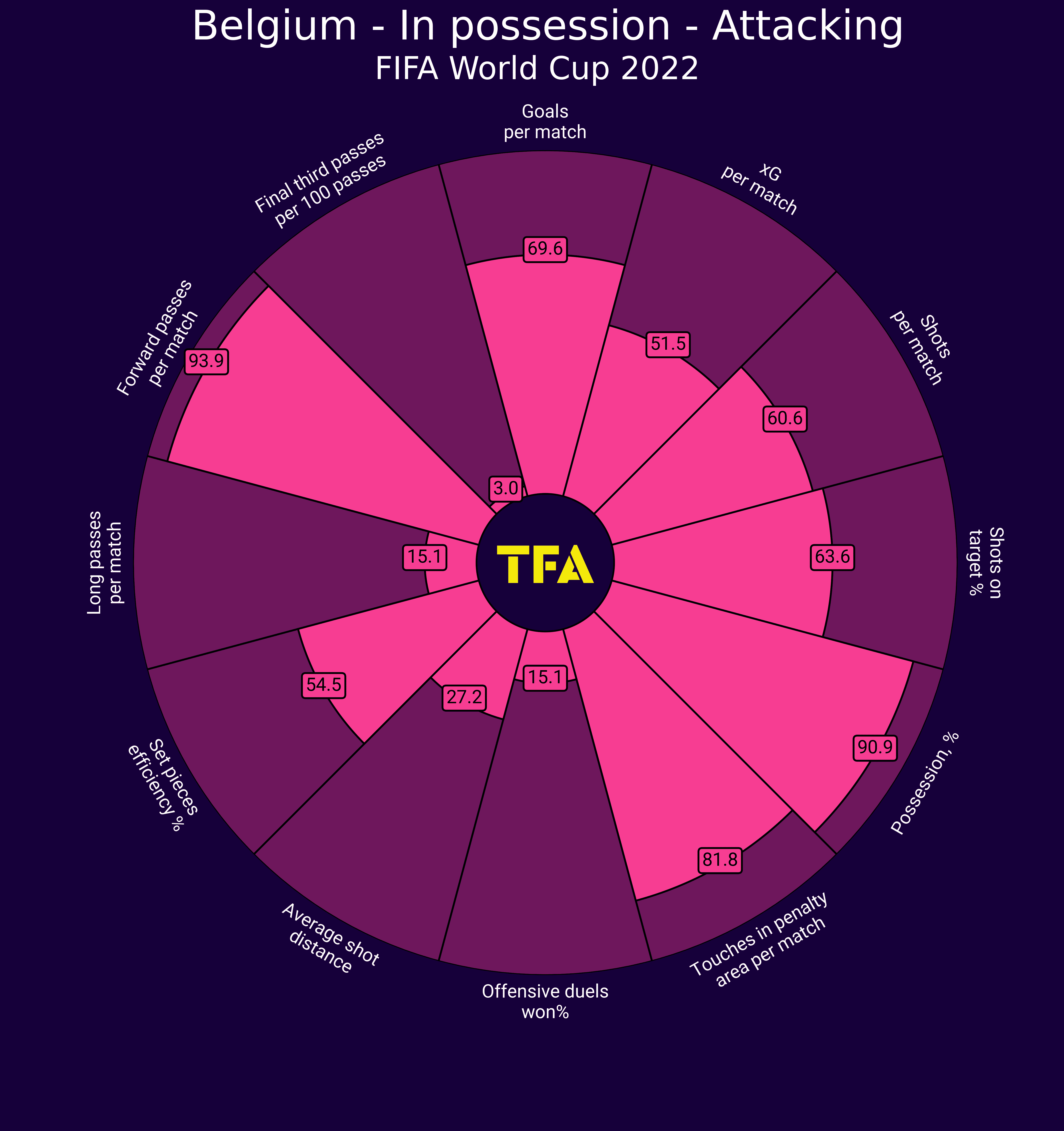
During the build-up phase, Belgium will build up through the centre-backs. The team will then transition into a 3-2-4-1 shape during the first phase of the build-up. The wing backs will start to push high and maintain width as the image below shows.
As the two central midfielders drop deeper so will the two number 10’s. This creates a box midfield centrally. Overloading the pitch centrally during this stage of the build-up draws the opposition inside and makes them stay compact as they attempt to block the passing lanes into De Bruyne and Hazard. Creating more space out wide and giving Belgium the chance to move the opposition’s defensive block from side to side.
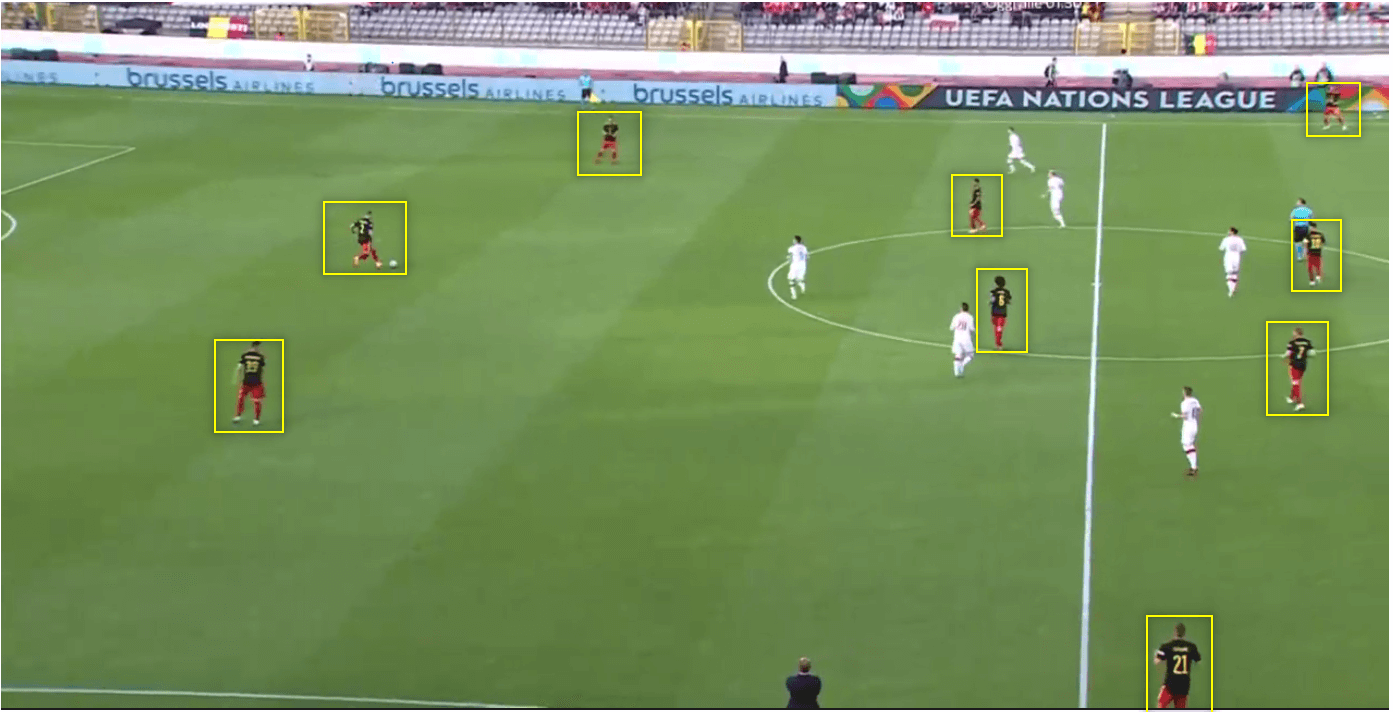
When the opposition presses them high and tries to stop them build up through the centre, Belgium will look to beat the press by creating overloads in the wide areas to attract the opposition towards the Ball. You can see the 4v2 overload in the image below and how Poland has six players moving further towards Belgium’s goal. This suits Belgium as it creates more space to attack.
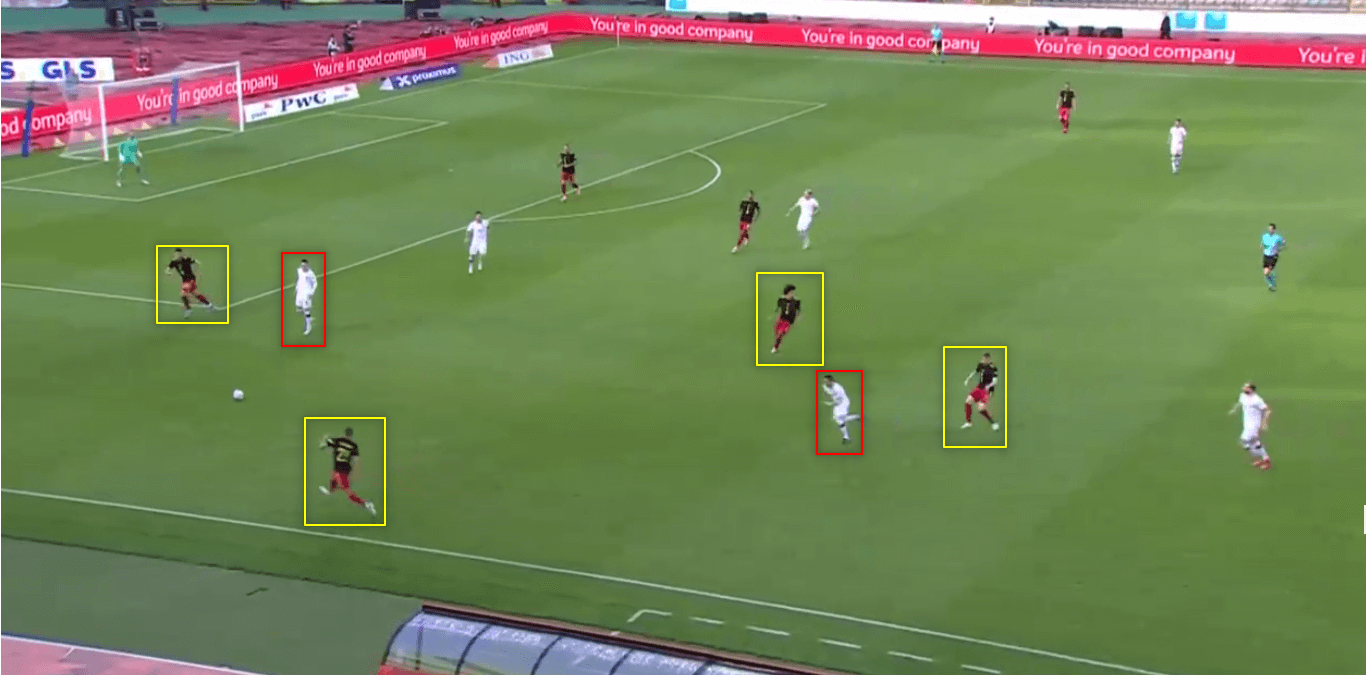
As they build from the first phase to the second phase of the build-up their attacking shape maintains the 3-2-4-1 as they look to put as much pressure on their opponent’s defensive line. The two number 10’s will play higher and pick up pockets of space closer to the striker and look to exploit the space in between the lines.
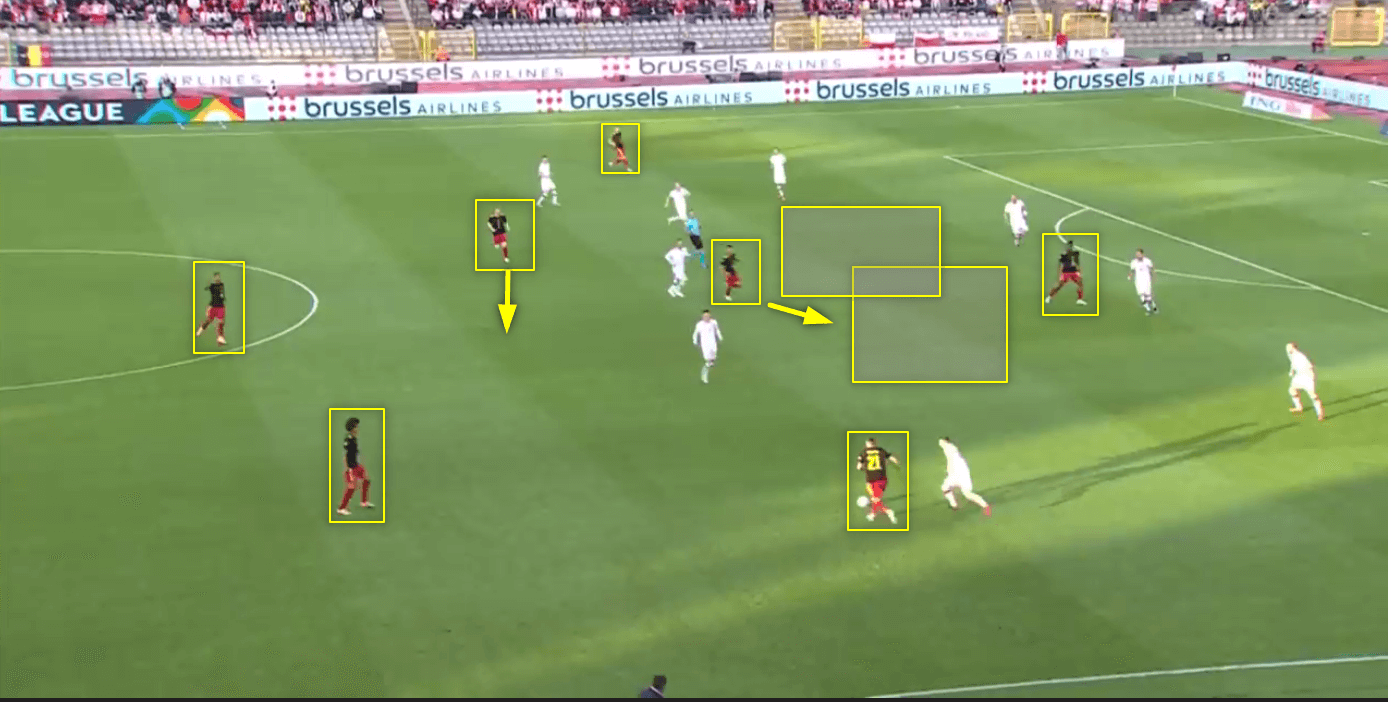
The image above shows how Belgium entered the attacking third. In this image, De Bruyne and Hazard split their runs with one running behind the midfield and one running in front. This disrupts their opponent’s midfield line. Having players with this level of individual ability allows Martínez to give his players freedom within his tactics.
Teams tend to allow Belgium to keep possession of the ball and look to combat that with a solid and organized defensive block. This is when the importance of the two numbers 10’s in Belgium’s formations comes to show. Their ability off the ball and their ability to see space to exploit help disrupt the opponent’s defensive shape but also create space for others.
Look at How De Bruyne and Hazard both move towards the ball carrier in this pattern of play below. Realistically, they know Alderweireld won’t play that passes as the Netherlands have been blocking the passing lanes centrally, but by doing this they are moving the Dutch players from their position. It allows Alderweireld to be more direct and creates a 1v1 out wide.
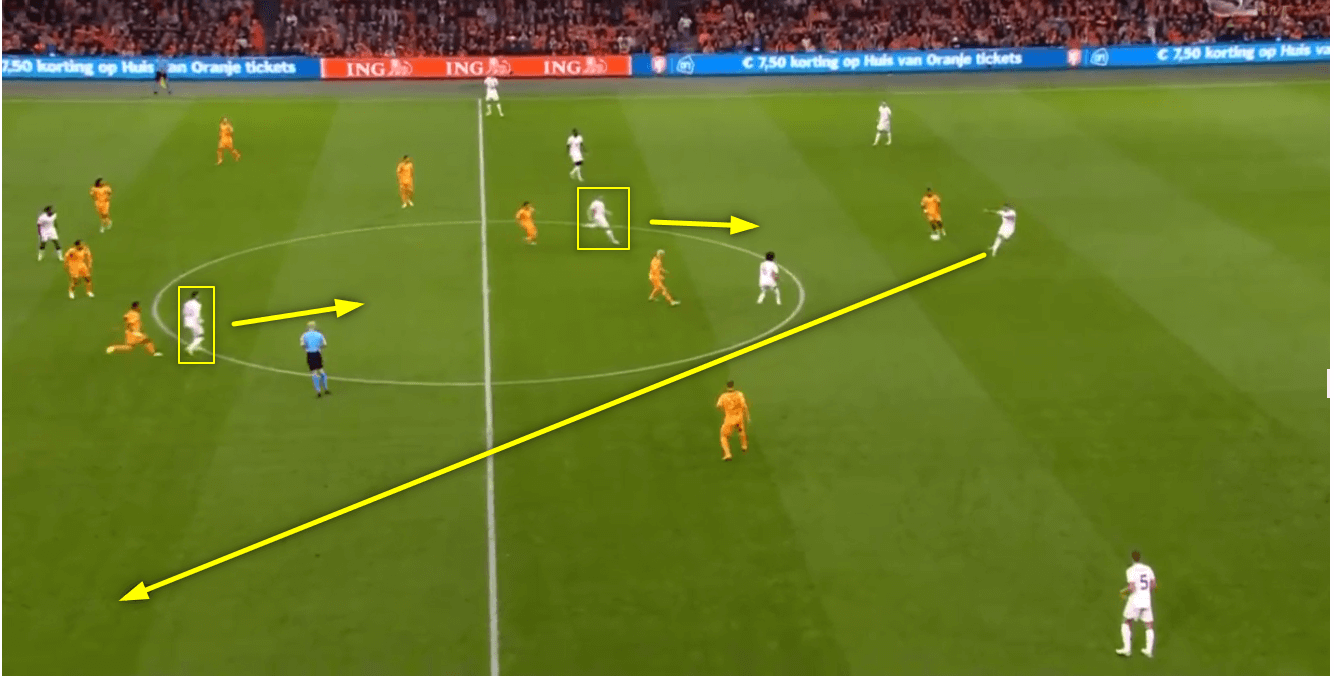
Defensive phase
The Pizza chart below shows the defensive output of Belgium from this calendar year. It measures their percentile ranking for each defensive statistic and how they fare against the other national sides.
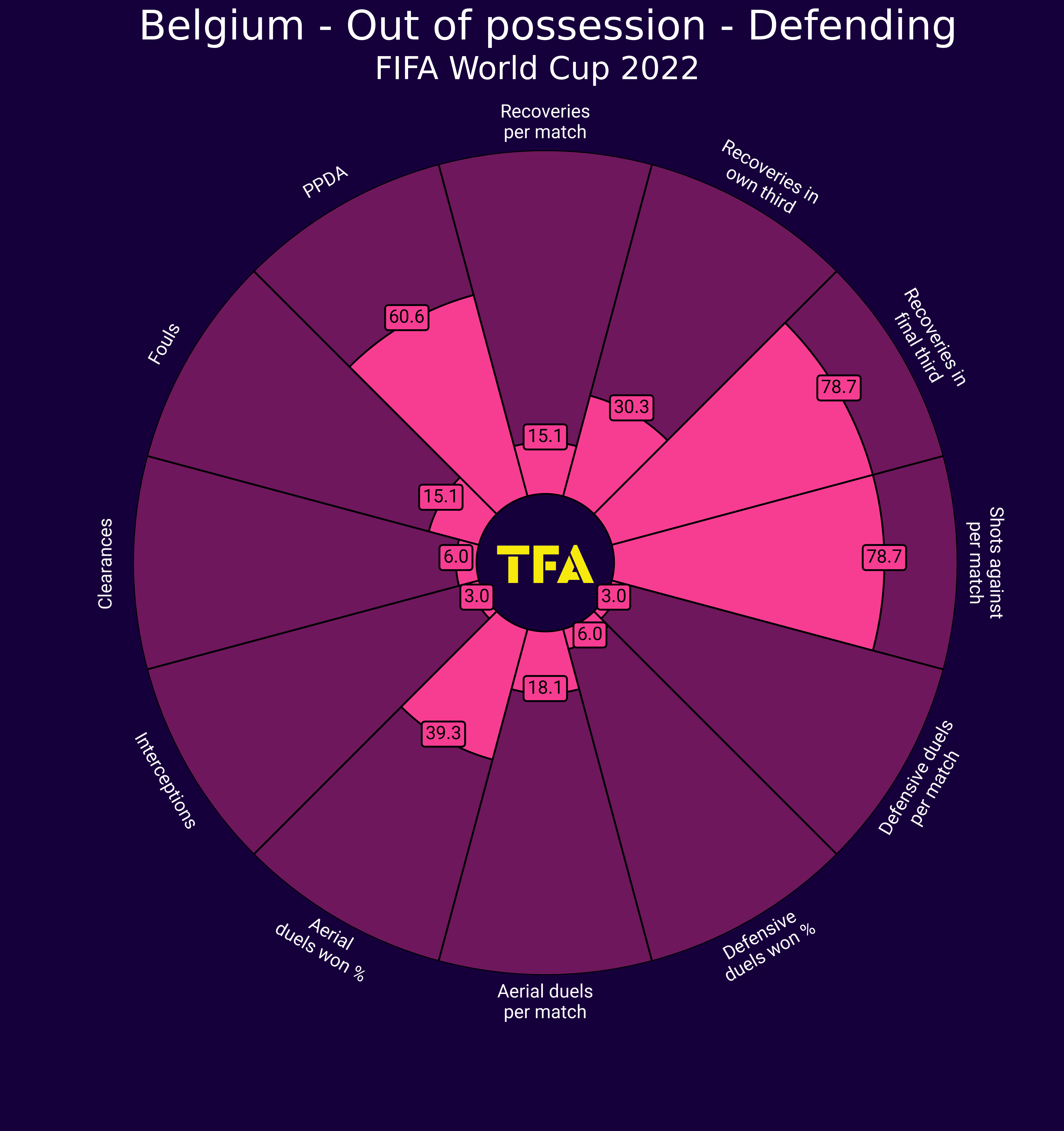
For a team that looks to keep as much of the ball as possible Belgium are a lot more vulnerable when they lose possession than they should be. At times it is clear the team lack a plan on how to react when they lose the ball.
They allow their opposition too many shots at goal. Their percentile ranking of 78.7 for shots conceded per match confirms they concede too many attempts on goal for a team whose individual talent should make them more difficult to play through.
The number of defensive duels, aerial duels and interceptions they make and are successful with is far too low when compared to other teams.
The team’s defensive stats along with the age of the squad will have played a role in how Roberto Martínez set up his team’s defensive shape. A team who wants to keep possession of the ball naturally will want to win the ball back as soon as they lose it, so they will inevitably look to counter-press to win the ball back. Belgium don’t press as aggressively as they did when Martínez first took over in 2016.
When they lose possession, Belgium now looks to transition to a 5-2-3 or a 5-2-2-1 defensive block with minimal space between the lines and a limited distance between the last of defence and the first line of the defence.
This image shows The Red Devils defending in a low block. They are still maintaining pressure on the ball but it is man orientated while the rest of the team maintains the shape. You can see how they pushed Poland to one side of the pitch with little opportunity to play through them or play over them because of how compact they are.
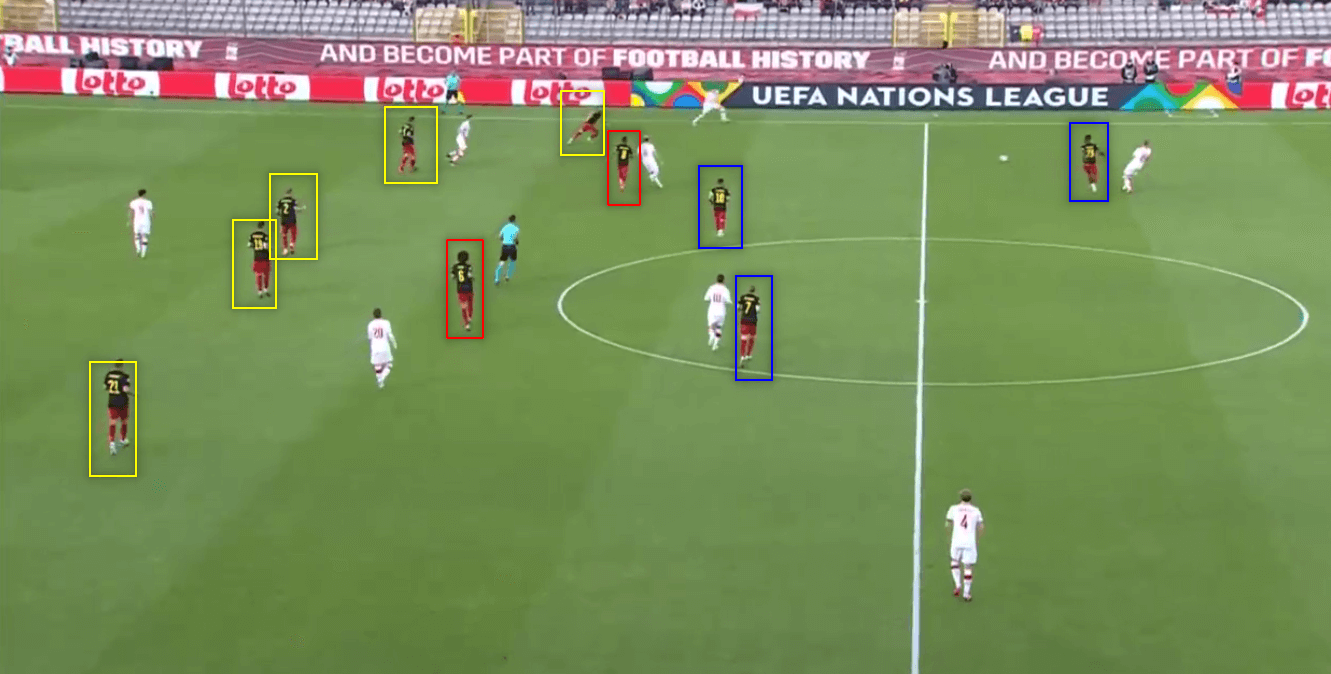
Once the play is forced backwards, they will move to a middle block as a unit, their principles don’t change. The team protects the pitch through the centre and forces the play out wide through man-orientated pressing.
Once the ball progressed through the wide areas. The team’s intent on winning the ball becomes more aggressive. The image below shows Yannick Carrasco immediately looking to put pressure on Poland right back before he receives the ball.
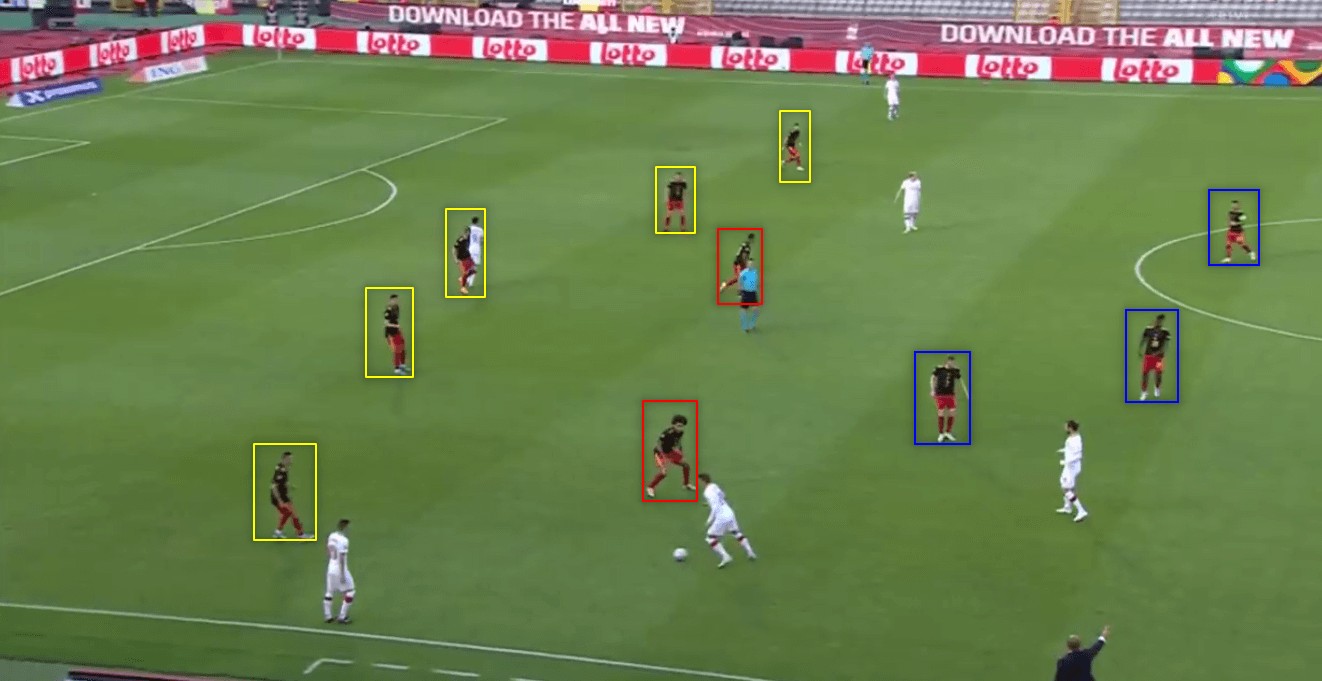
Their high block differs, as they don’t look to pressure on the ball until the first pass out of defence is made. They will let the opposing centre-backs hold possession and then once the first pass is made the individual press is triggered.
The image below shows this. Michy Batshuayi is not putting pressure on the ball carrier. The whole team is keeping shape until the first pass out of defence is made. This is so the team can keep a limited amount of space between the two number 10s and the two central midfielders.
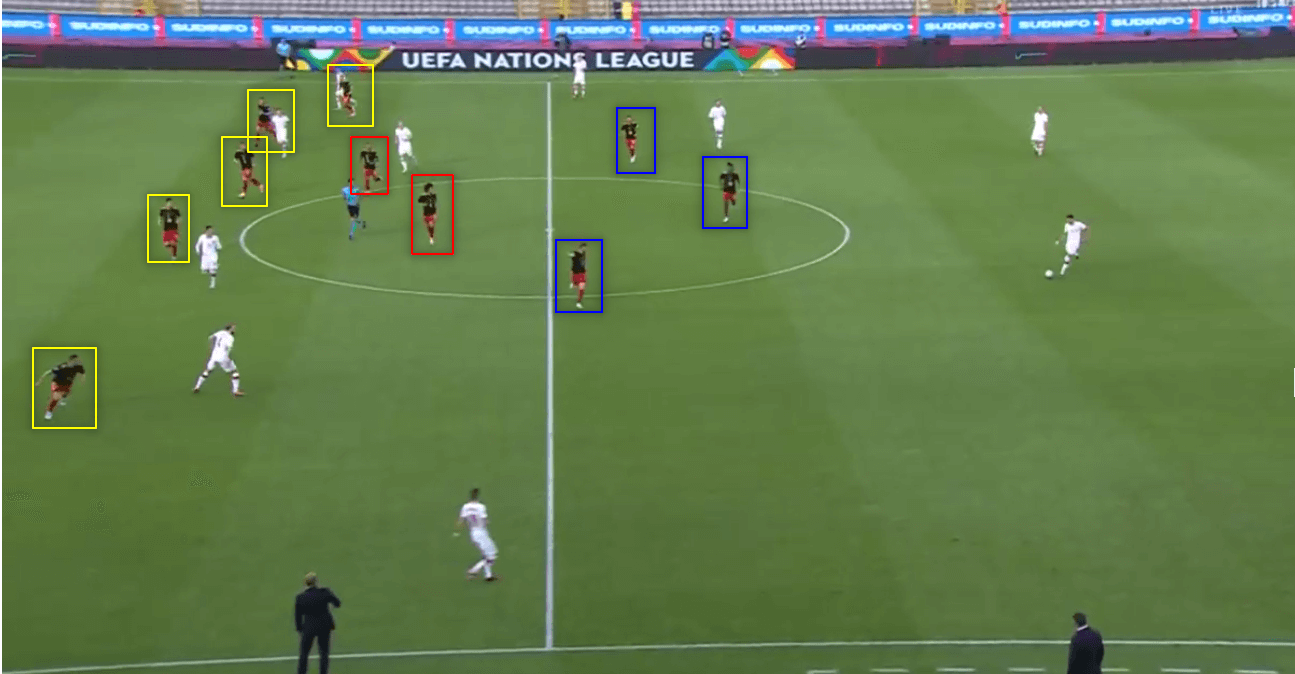
Playing high up the pitch and not exerting constant pressure on the ball leaves Belgium vulnerable to long balls behind their defence and with the lack of pace between the centre backs it represents a high-risk approach.
Transitions
The way Belgium set up their defensive block makes it look like they will counter-attack aggressively during their attacking transition. However, this is not the case. When Belgium win possession, they look to regain control of the ball and regain a positional play structure.
This image is a prime example of how Martínez wants them to remain patient when they win the ball. As Poland’s attack breaks down and Tielemans regains the ball, you can see how he has two possible passing options available to progress the ball forward and transition quickly into an attack. Carrasco, Castagne and De Bruyne are all in space to implement a quick transition. However, Tielemans opted to pass back to the centre-backs and the team restarts the build-up phase.
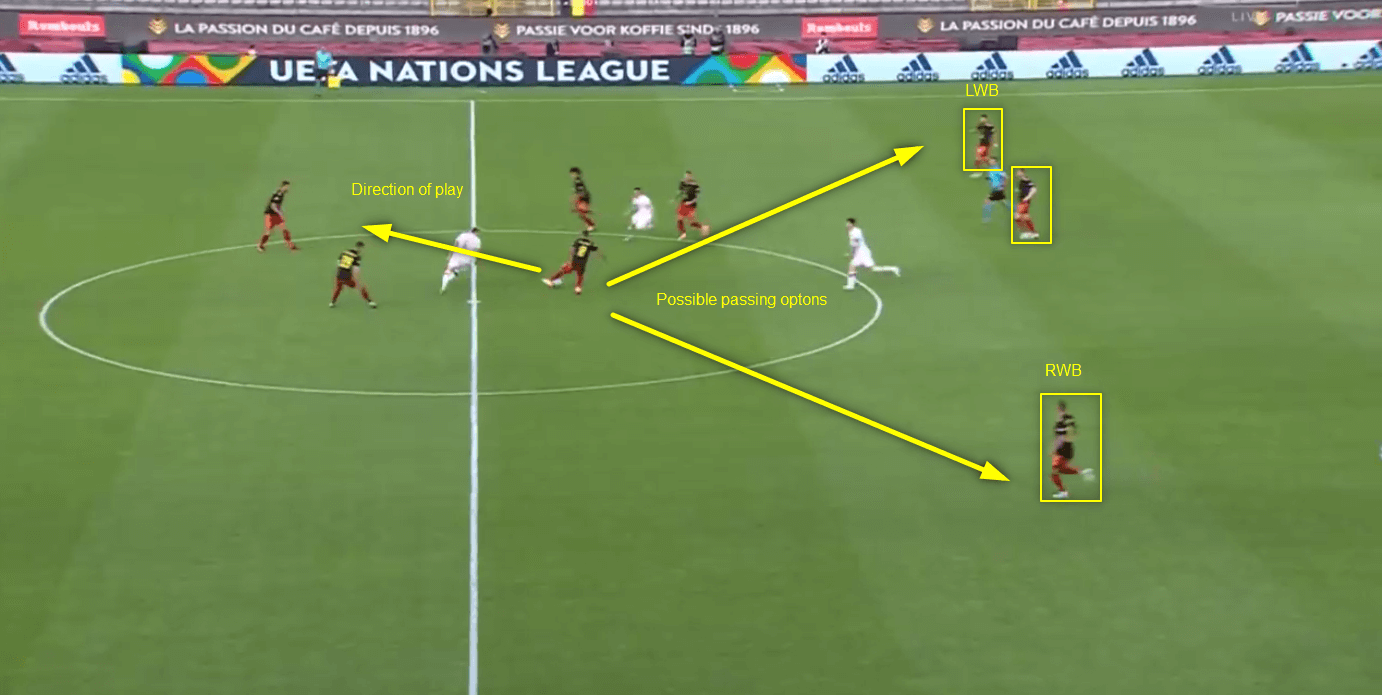
This can be counter-intuitive as the team’s defensive block is set to lure their opposition forward and vacate space to attack. With Belgium not aiming to take advantage of the space then they are allowing their opponents the opportunity to regain defensive stability.
Their defensive transition is when they are at their weakest and most vulnerable. That initial period after losing the ball is when Belgium lacks any organisation and loses all defensive structure.
The image below shows Belgium’s defensive transition. At this point, there is lots of space behind Belgium’s wingbacks for Poland’s attack. The wing-backs are out of position which is expected because of the attacking influence they hold when Belgium are in possession.
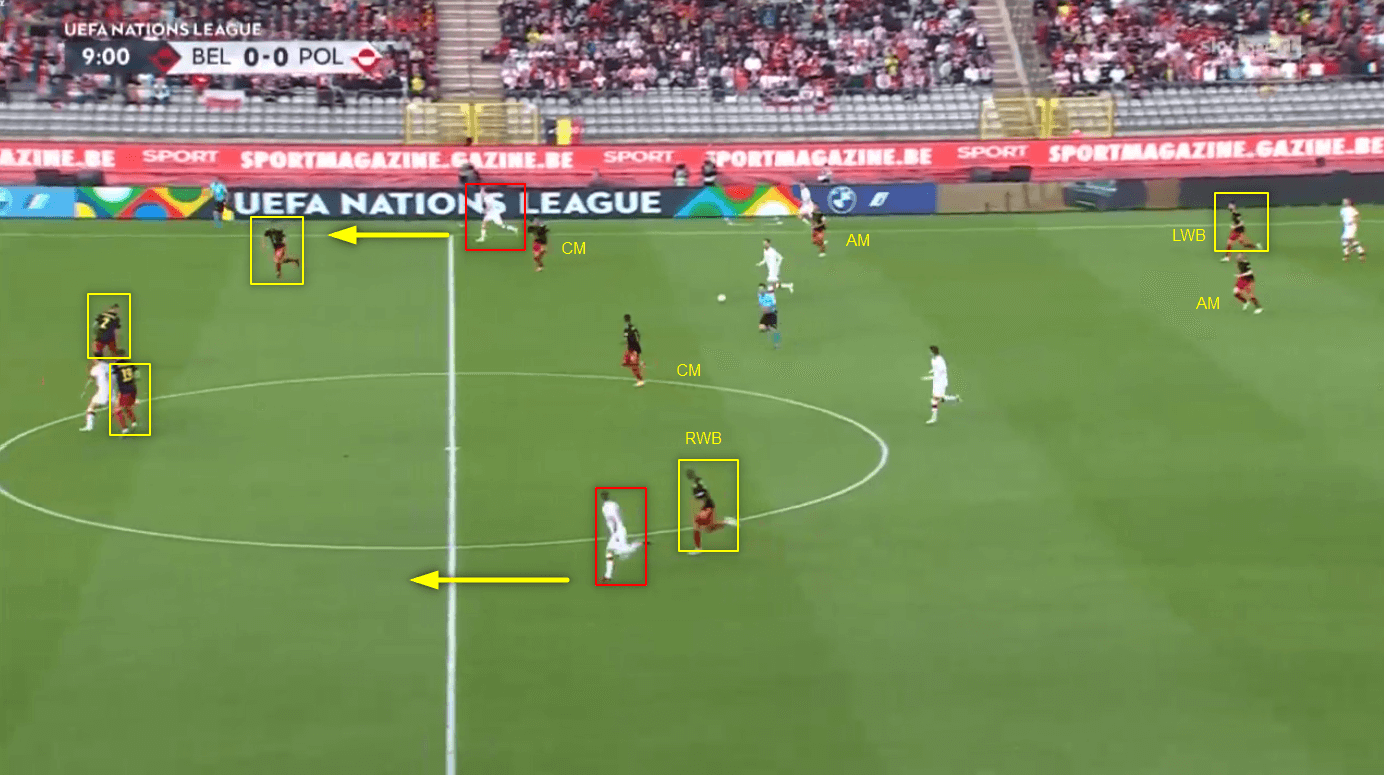
A common problem we have noticed with Belgium during their defensive transition is that whilst the wingbacks attempt to regain their defensive position, they don’t disrupt their opponent’s attack. When a team loses the ball, they should either counter-press their opponents immediately to stop them from attacking or should drop into a defensive shape immediately and protect a specific area of the pitch.
The example above shows Belgium can get caught not doing any. Poland regains the ball down Belgium’s left-hand side, and then they pass inside straight away. The ball carrier holds possession in the centre of Belgium’s box midfield and is under no pressure and the wingbacks have yet to regain their shape. This puts Belgium in a poor position defensively. Poland has the choice to attack the space right across Belgium’s defensive third.
This will prove to be Belgium’s undoing as they progress through the tournaments and face better teams with more quality.
Defenders
How Belgium performs defensively will play a key role in their overall performance. Both Jan Vertonghen and Toby Alderweireld are still likely to play in the manager’s preferable starting XI and whilst their ability to play out from the back and experience will be vital, their age indicates their best years are behind them. Vertonghen is 35 and Alderweireld is 33.
As we have already mentioned in this analysis, Belgium will look to control the game through possession, play as high up the pitch as possible and use full coverage of the pitch when doing so. The wingbacks could either push high and provide the width or push high and play inside. When possession is lost, the space in behind and the lack of pace between Vertonghen and Alderweireld will make Belgium vulnerable to quick transitions and direct balls when the play is turned over.
Midfielders
The midfield will be crucial to how well Belgium controls the game in possession.
They will be heavily involved in the first and second build-up phases of play as they will have the responsibility of linking the play through each third of the pitch. We know how Belgium will play; Roberto Martínez won’t change his approach. they will look to build through the defence into midfield and then through to the attack. Witsel’s and Tielemans’ distribution from this area will be important to how well Belgium perform when they hold possession.
Their positioning out of possession will also play an important role in how far the Belgians progress. Belgium are likely to attack in a 3-2-5 shape. Tielemans and Witsel will form the double pivot in that shape. This allows Belgium to keep five men behind the ball and provide protection for the three central defenders. Their ability to be able to control the space and protect the pitch centrally will determine how well Belgium perform defensively.
The wing-back positions can be the deciding factor on if the 3-4-2-1 formation works or not. Their ability to be able to switch between playing as a winger in the attacking third and a full-back in the defensive third determines how well the team transitions between attack to defence and defence to attack. The wing-backs occupy the wide channels and provide wide width when Belgium attacks in a 3-4-2-1 or 3-2-5 and they defend the wide areas and join the defensive line to allow the team to defend with a five-man defence.
Attackers
This could depend on the fitness of Romelu Lukaku. The Inter Milan striker has only played three games this season and has been injured since August. Although he is on track to be fit for the world cup, it is uncertain how much match practice he will gain beforehand.
If he is fit, he will start and be the focal point for the team and therefore this will see Martínez play with two attackers behind Lukaku in a 3-4-2-1 formation. If Lukaku is not fit and they want to play the same formation, then Michy Batshuayi will start in his place so he can keep that same approach.
Playing Eden Hazard or Dries Mertens as the lone striker could be an option if needed. Although this would mean a change in Belgium’s attacking play. If either of them plays they would look to operate as false nine meaning you see them dropping between the line and pulling away from the central space to occupy pockets of space. Martínez would then have to change the team’s attacking structure and make sure he has someone capable of attacking the space that a false nine vacates.
Key player
There is no doubt that Belgium has a raft of talented players within their squad. However, it is Kevin De Bruyne who remains the stand-out player in this group and whose performances are vital to how well the team plays and how well the manager’s tactical approach is implemented. Despite the talent of Eden Hazard, Romelu Lukaku and Thibaut Courtois, it’s De Bruyne whom this Belgium team is built around, as one of the best players in world football.
Making sure Kevin De Bruyne gets on the ball in key areas will make sure Belgium are purposeful in possession as they build up to the final third and penetrate the defence of the opposition.
For Manchester City, Pep Guardiola allows him the freedom of the attacking third. He is often played in midfield in a 4-3-3 formation but because of how Guardiola wants his team to attack and how the players are positioned to allow De Bruyne to be less disciplined positionally, his role could be considered a free 8. This enables him to affect the game further forward.
It’s the same with Roberto Martínez and Belgium. The 3-4-2-1 formation is set to allow the number 10s to be able to move around the attacking third and support the play out wide, through the centre and in the opposition’s penalty area. Given the data we have compiled below, it shows this is a good tactical ploy playing De Bruyne as one of the number 10s.
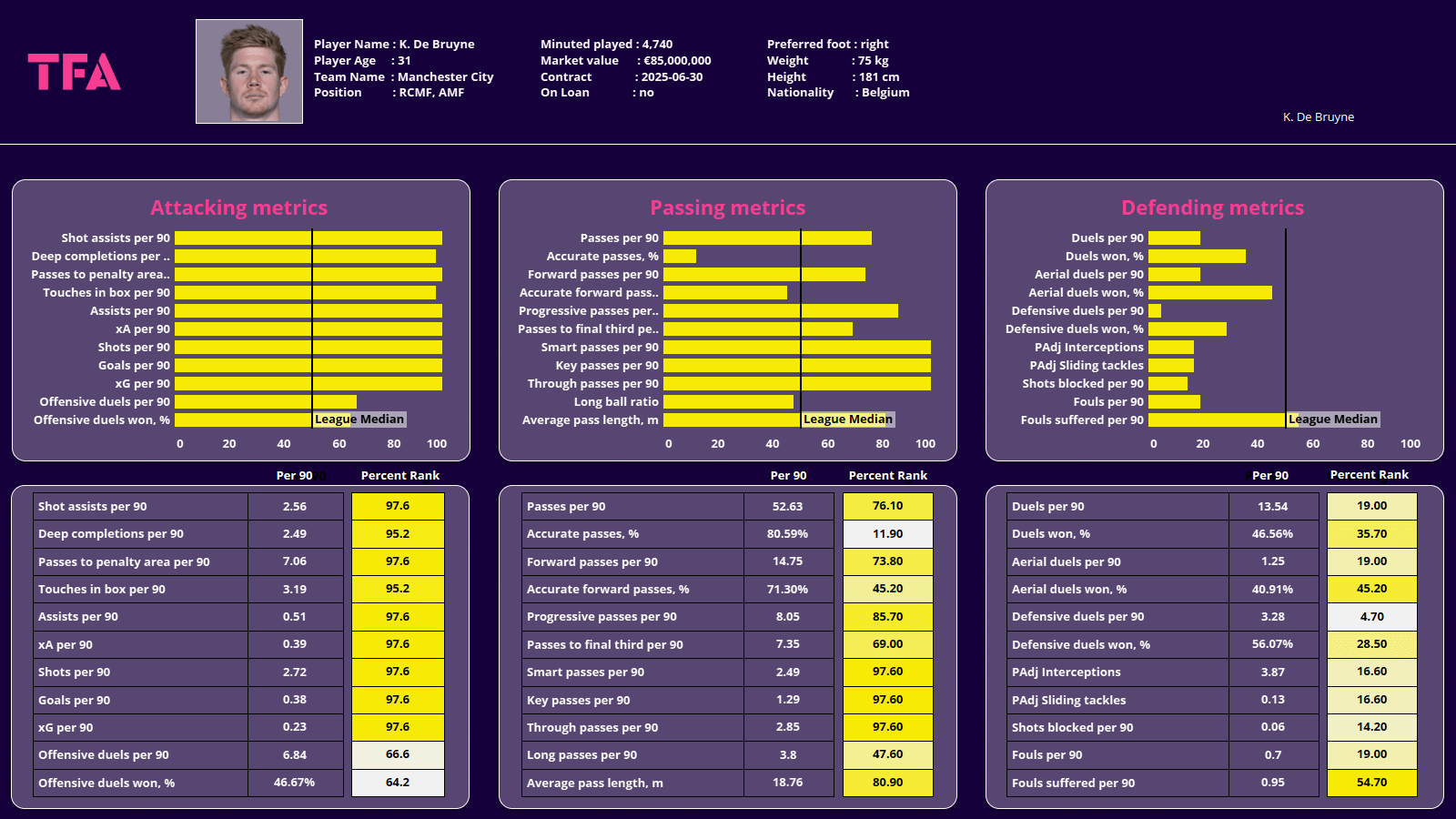
We have compiled Kevin De Bruyne’s data and measured how well he performs against all the other attacking midfielders in the Premier League for this calendar year. The data shows the stats he achieves per 90 minutes played along with the percentile rank showing how well his stats measure against his peers.
The data shows how well he performs in his team’s attacking output. For his passing ability, you can see his percentile ranking is 97.60 for smart passes, key passes, and through passes. As well as having a percentile ranking of 85.70 for progressive passes, it shows how creative De Bruyne is with his passing range and cements him as the one of world’s best and most creative passers.
His attacking output also makes him one of the world’s best attackers in the final third. Other than offensive duels his lowest percentile ranking for attacking statistics is 95.2. That includes shots per 90 goals per 90 and expected goals per 90. So, as well as being one of the most creative players through passing, he is clinical in front of the goal.
Tournament Prediction
The quality of the individuals that Belgium have available will ensure they perform to a certain standard, and this time will be no different. This will be Roberto Martínez’s second World Cup in charge and third overall, and they will be expected to go deep into the tournament.
After reaching the quarterfinals in Brazil in 2014 and then reaching the semi-finals in Russia in 2018, both Martínez and the fans will be hoping they can go at least one further.
However, their route to the final won’t come easy. If they win their group, which is expected, they are likely to face Germany or Spain in the second round. If they manage to be successful in that tie, they will likely meet one of Portugal, Brazil, or Uruguay in the quarterfinals.
If the Red Devils manage to repeat the third-place finish they achieved in the last World Cup it would be an exceptional achievement for Martínez and his side this time around.

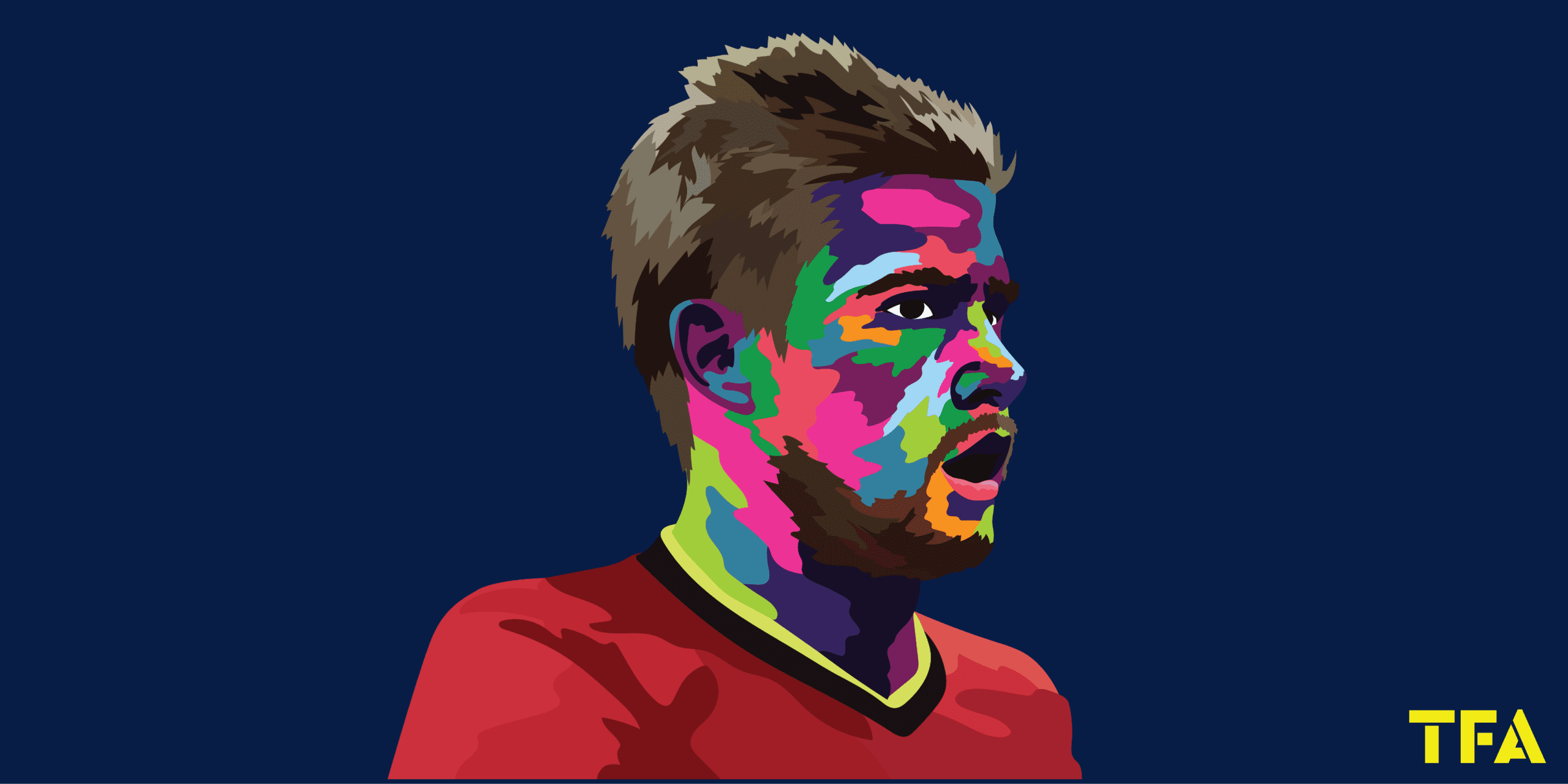




Comments